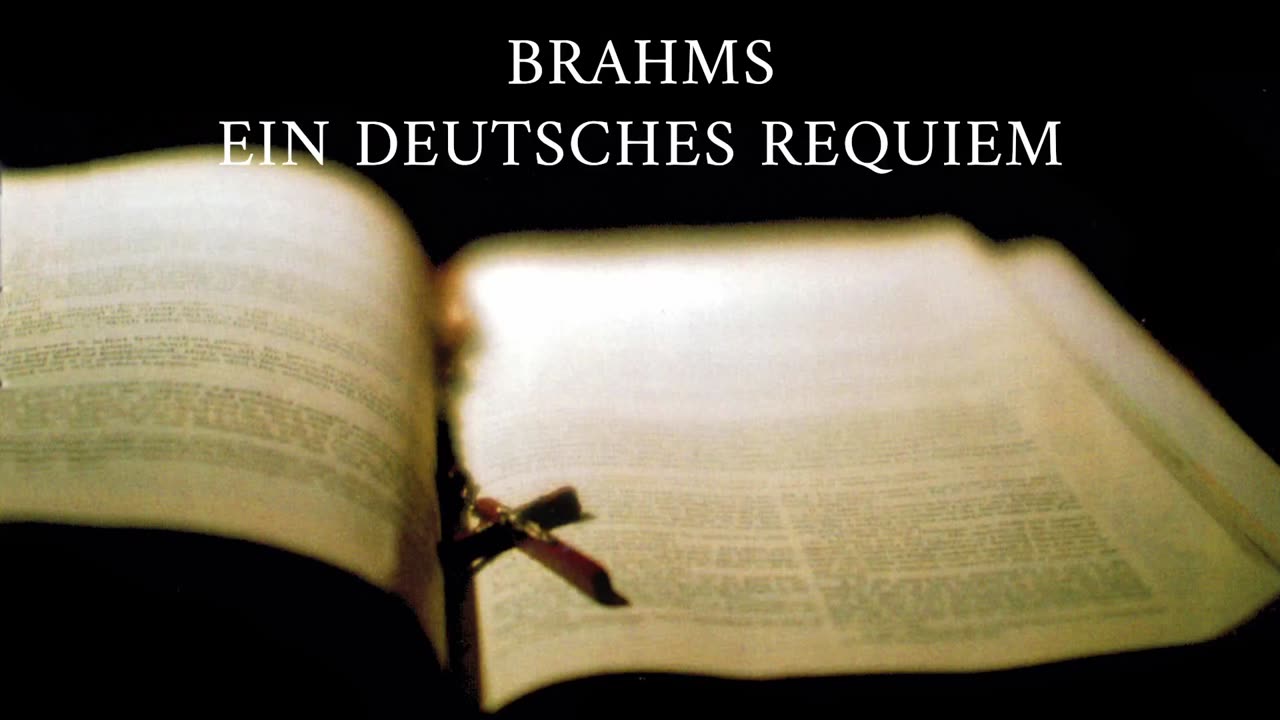Premium Only Content

Ein deutsches Requiem, in F major - Johannes Brahms 'Stich-Randall, Bamberger, 1958'
Composition Year: 1865–68
First Performance: 869-02-18 in Leipzig, Gewandhaus (complete) Emilie Bellingrath-Wagner (soprano), Dr. Kückl (baritone), Gewandhaus chorus, orchestra, Carl Reinecke (conductor)
Recorded: Hamburg, 1958
~
Performers:
Soprano Vocals – Teresa Stich-Randall
Baritone Vocals – James Pease
Choir – Chœurs de la Singakademie de Hambourg
Orchestra – Norddeutsches Symphonie-Orchester, Hambourg
Soprano Vocals – Teresa Stich-Randall
Carl Bamberger - Conductor
~
00:01 1. Selig sind, die da Leid tragen. Ziemlich langsam und mit Ausdruck
10:17 2. Denn alles Fleisch, es ist wie Gras. 4. Langsam, marschmäßig
23:54 3. Herr, lehre doch mich. Andante moderato
33:37 4. Wie lieblich sind deine Wohnungen. Mäßig bewegt
39:51 5. Ihr habt nun Traurigkeit. Langsam
47:20 6. Denn wir haben hie keine bleibende Statt. Andante, Allegro
58:09 7. Selig sind die Toten. Feierlich
~
Work:
A German Requiem, to Words of the Holy Scriptures, Op. 45 (German: Ein deutsches Requiem, nach Worten der heiligen Schrift) by Johannes Brahms, is a large-scale work for chorus, orchestra, a soprano and a baritone soloist, composed between 1865 and 1868. It comprises seven movements, which together last 65 to 80 minutes, making this work Brahms's longest composition. A German Requiem is sacred but non-liturgical, and unlike a long tradition of the Latin Requiem, A German Requiem, as its title states, is a Requiem in the German language.
~
History
Brahms' mother died in February 1865, a loss that caused him much grief and may well have inspired Ein deutsches Requiem. Brahms's lingering feelings over Robert Schumann's death in July 1856 may also have been a motivation, though his reticence about such matters makes this uncertain.
~
His original conception was for a work of six movements; according to their eventual places in the final version, these were movements I–IV and VI–VII. By the end of April 1865, Brahms had completed the first, second, and fourth movements. The second movement used some previously abandoned musical material written in 1854, the year of Schumann's mental collapse and attempted suicide, and of Brahms's move to Düsseldorf to assist Clara Schumann and her young children.
~
Brahms completed all but what is now the fifth movement by August 1866. Johann Herbeck conducted the first three movements in Vienna on 1 December 1867. This partial premiere went poorly due to a misunderstanding in the timpanist's score. Sections marked as pf were played as f or ff, essentially drowning out the rest of the ensemble in the fugal section of the third movement. The first performance of the six movements premiered in the Bremen Cathedral six months later on Good Friday, 10 April 1868, with Brahms conducting and Julius Stockhausen as the baritone soloist. The performance was a great success and marked a turning point in Brahms's career.
~
In May 1868 Brahms composed an additional movement, which became the fifth movement within the final work. The new movement, which was scored for soprano soloist and choir, was first sung in Zürich on 12 September 1868 by Ida Suter-Weber, with Friedrich Hegar conducting the Tonhalle Orchester Zürich. The final, seven-movement version of A German Requiem was premiered in Leipzig on 18 February 1869 with Carl Reinecke conducting the Gewandhaus Orchestra and Chorus, and soloists Emilie Bellingrath-Wagner and Franz Krückl.
~
Wikipedia biography: https://bit.ly/3kbFPC0
~
ATTRIBUTION
Music contained in this video is licensed under: Public Domain - Non-PD US / Editions Atlas “Eblouissante Musique Sacrée”, 1958 / Collection personnelle
-
 1:12:32
1:12:32
Classical Music P.D.
2 years agoSymphony No.5 - Gustav Mahler 'James Levine - 1977'
155 -
 17:53
17:53
Forrest Galante
4 hours agoHow I Joined a Dangerous Remote Tribe (feat. Nelk Boys)
91 -
 LIVE
LIVE
Vocalot
16 hours agoDay 6! New Here! New Rumble Friends!? 🤙
1,539 watching -
 34:27
34:27
The Connect: With Johnny Mitchell
10 hours ago $1.28 earnedCan He Stop Them? Inside Trumps War On Mexican Drug Cartels & The New Era Of Mexican Organized Crime
5.53K1 -
 LIVE
LIVE
Tundra Tactical
2 hours ago $1.76 earnedLuis Valdes Of GOA Joins The Worlds Okayest Firearms Live Stream!!!
629 watching -
 1:03:41
1:03:41
Man in America
10 hours agoAre Trump & Musk the COUNTER-ELITES? w/ Derrick Broze
20.4K5 -
 LIVE
LIVE
DLDAfterDark
1 hour ago $2.32 earnedDLD Live! SHTF Handguns! Which Would You Choose?
525 watching -
 1:50:38
1:50:38
Mally_Mouse
4 hours agoSaturday Shenanigans!! - Let's Play: Mario Party Jamboree
26.1K -
 1:13:00
1:13:00
Patriots With Grit
8 hours agoWill Americans Rise Up? | Jeff Calhoun
20.3K10 -
 14:55
14:55
Exploring With Nug
8 hours ago $8.20 earnedWe Found Semi Truck Containers While Searching for Missing Man!
40.4K7